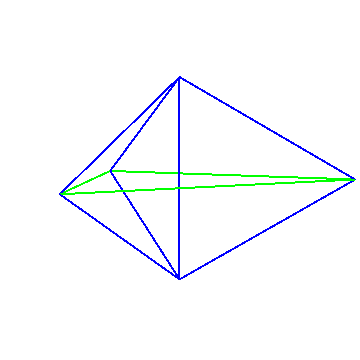A Regular Tetrahedron is a cool Polyhedron.
A regular tetrahedron has this property:
For any two of its vertices exists a third vertex, which forms a regular triangle with these 2 vertices.(It doesn't necessarily have to be a face of it).
Are there any other polyhedrons that have the same property?
I think there isn't such a polyhedron. But not sure how to prove it. I've tried proving that there isn't an irregular tetrahedron with this property, assuming that there is a pair of unequal sides.
Current answers are a little confused with the conditions of the problem.
Solution 1:
Outline proof (assuming 'regular triangle' = equilateral triangle):
Consider a polyhedron with the stated property. It will contain three vertices A, B and C at the corners of an equilateral triangle.
A fourth vertex which forms an equilateral triangle with each pair of vertices taken from this set can occupy only two positions. Both of these positions - call them D and E - form a regular tetrahedron with A, B and C, so the regular tetrahedron is the only 4-vertex polyhedron with the property.
To preserve the property in relation to A, B and C, a fifth vertex must occupy position D or E (whichever of these positions was not chosen for the fourth vertex).
But the bipyramid with vertices at A, B, C, D, E does not satisfy the property, because ADE is not an equilateral triangle.
Hence there are no polyhedrons with the property having 5 or more vertices.
Solution 2:
The regular tetrahedron is not the only polyhedron with this property. A triangular bipyramid can be formed such that the line segment between any two of its vertices is part of an equilateral triangle of three vertices. For the base, take an equilateral triangle with side length $3/2$. Then add an apex with altitude $1/2$ above the center, and another apex at distance $1/2$ below the center. Then the apices are at distance $1$ from each vertex of the base triangle, and also distance $1$ from eachother.
Here's one set of coordinates for the 5 vertices of this bipyramid: $$ \left(\frac{\sqrt{3}}{2},0,0\right), \left(\frac{-\sqrt{3}}{4},\frac 3 4,0\right), \left(\frac{-\sqrt{3}}{4},\frac{-3}{4},0\right), \left(0,0,\frac 1 2\right), \left(0,0,\frac{-1}{2}\right). $$ Here's an animation of the line segments between these vertices.

Each of the $\binom{5}{2} = 10$ line segments between two vertices is either on one of the three blue equilateral triangles, or on the green equilateral triangle.
Solution 3:
This isn't a very good answer: it only applies if the regular triangles are all faces. I'll leave it here if it might help anyone. Please be good enough not to downvote
(1) Let F, E and V be the number of faces, edges, and vertices on a polyhedron.
(2) Refer to http://www.math.ku.edu/~jmartin/courses/math409-S13/polyhedra.pdf for proof that E <= 3V - 6.
(3) Note that an even more fundamental property which is implied in your statement is that every pair of vertices forms an edge (only true if the triangle must be a face). That being so, $E = ^VC_2$ = $V(V-1)/2$.
(4) Put (3) and (2) together so that 0 >= $V^2 - 7V +12$. Equality holds for V = 4 (tetrahedron) but cannot be satisfied for V > 4.